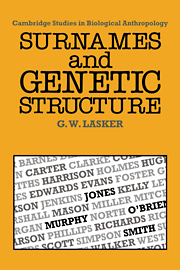Book contents
- Frontmatter
- Contents
- Preface
- 1 Introduction
- 2 History of surname studies in human biology
- 3 Sources of data
- 4 Methods
- 5 Isolates and inbreeding
- 6 Island versus distance models: the Far East and Oceania
- 7 The Americas and continental Europe
- 8 Scotland and Ireland
- 9 Regions of England
- 10 English cities and the general population of England and Wales
- 11 Specific surnames in Great Britain
- 12 Human population structure
- Literature cited
- Appendix maps and diagrams, of the distribution of 100 surnames in England and Wales
- Glossary
- Index
5 - Isolates and inbreeding
Published online by Cambridge University Press: 05 November 2011
- Frontmatter
- Contents
- Preface
- 1 Introduction
- 2 History of surname studies in human biology
- 3 Sources of data
- 4 Methods
- 5 Isolates and inbreeding
- 6 Island versus distance models: the Far East and Oceania
- 7 The Americas and continental Europe
- 8 Scotland and Ireland
- 9 Regions of England
- 10 English cities and the general population of England and Wales
- 11 Specific surnames in Great Britain
- 12 Human population structure
- Literature cited
- Appendix maps and diagrams, of the distribution of 100 surnames in England and Wales
- Glossary
- Index
Summary
Geneticists have long been interested in human inbreeding because of the known deleterious effects of close inbreeding (such as repeated sibling matings in domestic cattle). The effect of the lower levels of inbreeding that occur in human populations is less clear. Rare recessive genetic traits are found principally in the offspring of consanguineous marriages: for instance most cases of fructosuria occur in offspring of related parents (M. Lasker, 1941). Because such conditions are very rare, however, they have little importance. The significant question is whether inbreeding between first and second cousins (the usual levels in human populations) increases the risk of morbidity and mortality from common disorders. There is some controversy about it but the best large studies seem to show a small but significant effect (Schull and Neel, 1965).
The interest of biological anthropologists in inbreeding has usually been in the basic questions of the kinds and amounts of inbreeding that occur in the isolated populations that traditionally interest them. This has led to studies of small societies, such as that by Simmons et al. (1962, 1964) of the Aborigines of several islands in the Gulf of Carpentaria, Australia, that had been cut off so completely from each other and from mainland Australia that they had quite divergent gene frequencies. In South America, Ward and Neel (1970) found that seven villages of Makiritare Amerindians were virtually as diverse in frequencies of blood group genes as are the tribes of Central and South America from each other.
- Type
- Chapter
- Information
- Surnames and Genetic Structure , pp. 28 - 37Publisher: Cambridge University PressPrint publication year: 1985



